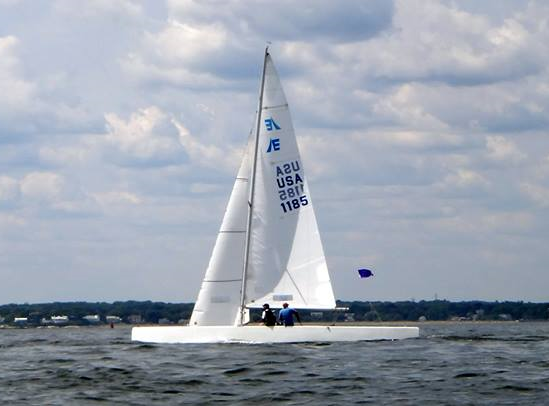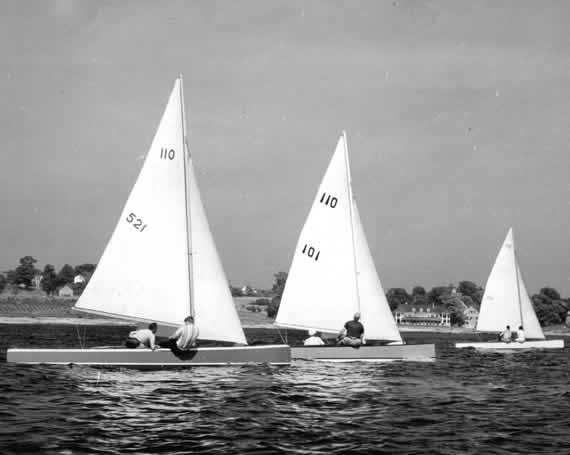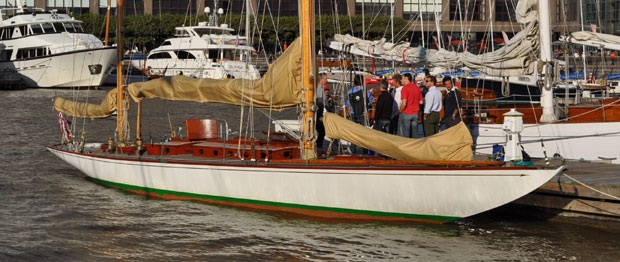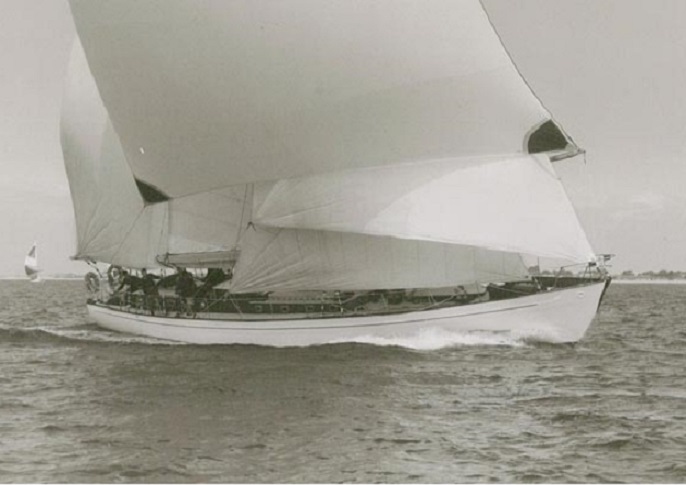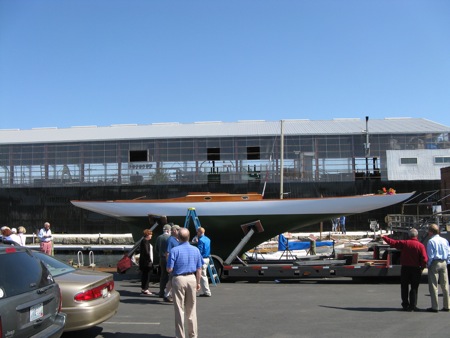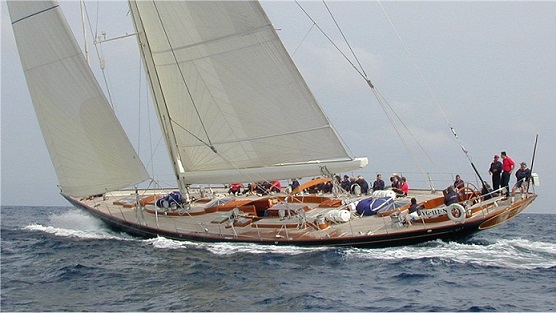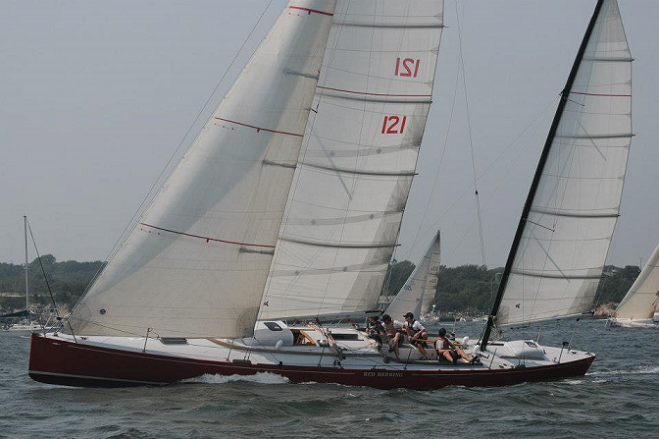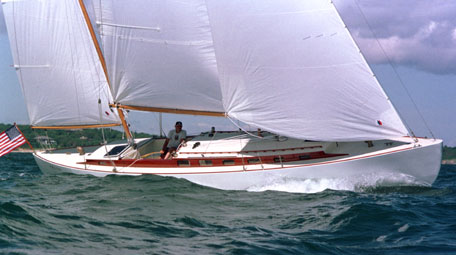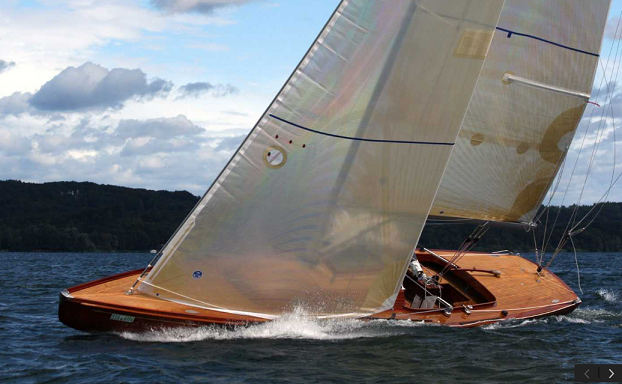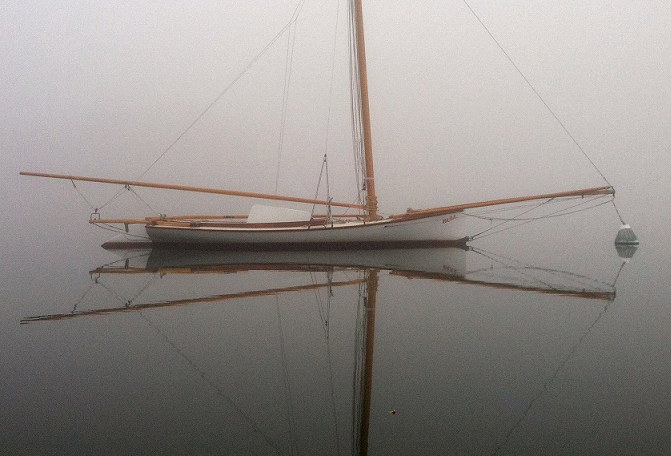2015 MARCH CLASSIC SAILBOAT OF THE MONTH – L.F. Herreshoff “Ben My Chree” –
Herreshoff “Ben My Chree” Specifications:
LOA: 28’0″ – LWL: 22’10” – Beam: 6’11” – Draft 2’9″ – 5’6″ – Displacement: 4,000 lbs – Sail Area: 265 sq ft – Ballast 2,400 lbs – Designer: L. Francis Herreshoff
“L. Francis Herreshoff designed this stunning boat in 1932 for Mr. Willoughby Stuart. Her plans are entitled 28′ Knockabout – Design No. 53. Mr. Stuart’s boat was built in 1933 and named BEN MY CHREE*, Gaelic for “darling of my heart”, BEN for short. He took her to his island home on Penobscot Bay, built a boathouse and railway for her, and she remained in the area for over 40 years, enjoyed by him and his family.”
In 2013, 80 years after her completion, Ballentine’s Boat Shop fully restored her. It took two years but she is as lovely as ever and should live to see another 80 years. Great care was taken to restore her to her original specs and L. Francis Herreshoff’s plans.

2015 FEBRUARY CLASSIC SAILBOAT OF THE MONTH -Knud Reimers “Vixen” –
Reimers “Vixen” Specifications:
Class Type: 15 Square Metre – LOA: 33″ 0″ / 10.05m * LWL: 21′ 8″ / 6.64m * Displacement: 1.3 Tonnes * Year Built: 1937 * Built By: Oscar Schelin Kungsors Boat Yard, Sweden * Restore By: 2011 Brooklin Boat Yard
Brooklin Boatyard had the following to say about the restoration of Vixen
Vixen was designed by Knud Reimers and built at the Kungsors boatyard in central Sweden by Oscar Schelin. Imported to the UK before the Second World War, she was one of only a handful of the elegant Square Meter Rule yachts. At the time building to the rule was prolific in the Baltic but scarcely known in the UK. As co-skipper Jack Gifford explains, “Much finer in form and lighter in displacement than her British counterparts, Vixen and her kind were viewed with suspicion by the (British) yachting establishment and with her light and efficient construction deemed as ‘un-seaworthy.” One famous British sailor had fallen in love with the Swedish Square Meter yachts and collaborated with Reimers to build his own yacht. That, of course, was Uffa Fox, and the boat he built at Cowes was the Vigilant. So confident was Uffa in its sea keeping that he set out to sail it to its spiritual homeland of Sweden to take part in the Swedish championships.
Vixen was purchased sight unseen by a client who had already had a very successful restoration experience with Brooklin Boat Yard that being the total restoration of Katrinka. While not always advisable to purchase a boat without even seeing it the client figured Vixen had to be in at least OK shape (she’s just sailed the North and Baltic Seas) so Vixen was packed into a shipping container and arrived at Brooklin Boat Yard in late July of 2011. While she was in good enough shape to sail that year’s Eggemoggin Reach Regatta it was clear that quite a bit of restoration work was needed.
Once Vixen’s restoration was competed approximately 75% of her frames and floors and 50% of her hull planking had been replaced along with a new deck, cockpit, cabin house and all new deck hardware.
Vixen now lives in Brooklin but she travels quite a bit (by land) to compete in as many of the classic yacht regattas as she can.
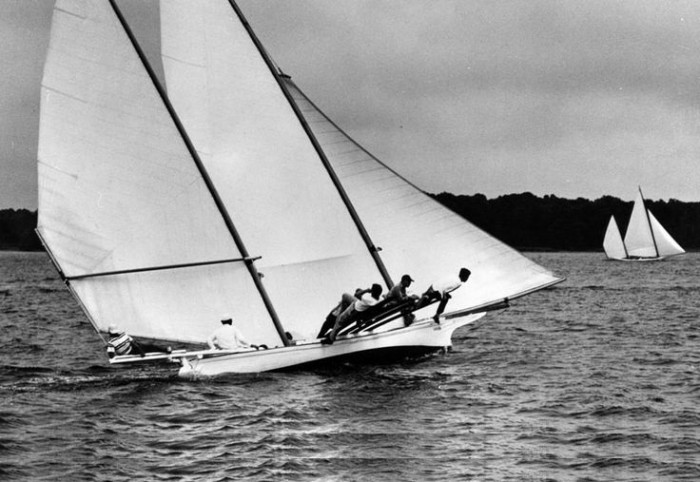
2015 JANUARY CLASSIC SAILBOAT OF THE MONTH – William Sidney Covington “Island Blossom” –
Historical:
Island Blossom is one of the last 22 surviving traditional Chesapeake Bay racing log canoes that carry on a tradition of racing on the Eastern Shore of Maryland . These vessels are of great historic significance because they are the sole active survivors of a vessel type indigenous to the Chesapeake region from the earliest days of its settlement
The Olde and New Worlds.
The aboriginal dugout canoe, so essential to life on the Chesapeake Bay for travel, harvest and trade, were the forefathers that were led to its adoption by 17th century European colonists using imported tools and technology.
Increasing world demand for the Chesapeake’s bounty of tobacco, fish and oysters led to a need for larger and faster work boats. By the mid-1800s, the addition of a keel, a tiny cabin,and side decks to a five-log hull resulted in a brogan,which moved this work boat beyond the definition of canoe.

The race was on to develop the swiftest sailing vessels. Over 6,300 sailing canoes were working the shores of the bay by the 1880s
“They were your family pickup truck”
William Sidney Covington, was the builder of the famed “Island” group of log canoes–the Island Bird, Island Bride, Island Belle, Island Beauty, and Island Blossom.
Island Blossom along with Island Bird are the only members of the original five-canoe group to survive. The Blossom was constructed to the order of William H. Myers, Sr. of Oxford who had her logs cut from a tract of woodland near Trappe and floated to Tilghman Island.
In the 1920s Island Blossom was sold to Stanley Evans of Elkton who only occasionally raced her. In 1952 she was purchased by John C. North, great grandson of the original builder, and brought back to Talbot County. Her hull was in good condition but she needed new spars and sails.
Between seasons the log canoes were raced along the shores of St. Michaels, Oxford, Cambridge, and many other shore towns. The races were highly publicized, often 50 boats would gather at the starting lines. It wasn’t unusual to see 5,000 spectators gather to see the races. The rules of racing were based on the over-all length of the boat. There were no limits on the amount of sail or crew each boat carried. Unballasted, some of the boats, when the mast were stepped, had at least a half a dozen men in the boats to prevent capsizing.
In the day it was the Eastern Shore against the Western Shore, Island Blossom versus the William V. Wilson. Island Blossom capsized during the race, relinquishing a mile lead to the Wilson before Blossom would be sailing again, but with her speed the Blossom would go on to win the race. It was said that a great many dollars changed hands after the race was over!
Island Blossom has won the Governor’s Cup and Covington trophies many times in the course of her racing career. Today she is sailed by Corbin Penwell. Corbin has sailed her to the season championship 4 times and if he does it again this year, it would be a record (and retire the trophy).The sails are cut by John Jenkins of Jenkins Sails. and John currently builds the sails for most of the fleet.
William Sidney Covington “Island Blossom” Specifications:
“Length and Width is all that Matters”
LOA: 32′ 7″ / 9.75m * Beam: 6′ 7″ / 2.04m * Draft: * Ballast: No Ballast * Displacement: * Sail Area: * Hull material: * Rig: * Built by: William Sidney Covington, Tilghmans Island, MD * Year Launched: 1892 * Restored By: * Current Name: Island Blossom * Original Owner: William H. Myers, Sr * Current Owner: North Family Trust * Sail Number: 9

2014 DECEMBER CLASSIC SAILBOAT OF THE MONTH – Robert Logan “Rawhiti” –
Historical:
Royal New Zealand Yacht Squadron, Commodore C. P. Murdoch presented to Mr. Pittar, upon the launching ceremonies, the club’s burgee, and noting through his adjournment, at a champagne luncheon, a toast of” The Owner” saying that Mr. Pittar had done more than any other man in the colony to uphold New Zealand yachting, and the reputation of Auckland-built yachts in New Zealand and Australia, sparing neither money nor time in the interest of the sport.
The new yacht “Rawhiti,” soon after her launching was sailed to Sydney, under the charge of Capt O. Schulze, a well-known trader to the islands, Mr. John Bell, a well-known Auckland yachtsman who rigged the yacht, and Mr. F. Bennett, a young man with good sea going experience, and of which the following reflects his experience.
At 4 pm on the 18th day of October 1905 the yacht “Rawhiti” weighed anchor in Waitemata harbour to commence a voyage of 1,280 miles / 2,059.96 kilometer across the Tasman Sea. A succession of circular gales and storms accompanied by high seas and head winds ensued during the stormy 28-day, 10 hour passage. Hove to for nearly 120 hours, and broaching once at midnight on October 31. under a double-reefed trysail and staysail, the little ship weathered it all, “a perfect marvel,” exceptionally seaworthy, testament to her skillful designers and builders.
Rationing of provisions began on the 9th of November on four biscuits a day. The crew discussed the advisability of putting in to Lord Howe Island to re-provision, but unfavourable winds prevented changing course. These rations continued until 1:16am on November 15th when land was sighted, with no more short rations left, a leading breeze allowed entry into Port Jackson and ending a long weary voyage across the Tasman Sea.
1940s – S W Marler, a New Zealand businessman, acquired the vessel (1945-1969), after an extensive refit, brought her back to New Zealand, with a stipulation that she would never race in Sydney again. Raced in New Zealand under the Royal New Zealand Yacht Squadron for over 20-years
1960s – Don Brooke acquired the yacht, modernizing her rudder and rig and added a above-deck cabin.
After Brookes’ ownership, through numerous changes in owners, sat deteriorating in Manukau Harbour
1990s – Wayne Hurst, a boat painter acquired her and completed an extensive restoration. In 1994 she was acquired by Brent and Rebecca Belemi, who raced her with the Classic Yacht Association.
2005-2011 – Greg Lee commences a six-year restoration of the century, lead by master shipwright Peter Brookes, Waimauku, NZ of Brooks Boatbuilders.
Robert Logan “Rawhiti” Specifications:
LOA: 54′ 0″ / 16.5m * LOD: * LWL: 34.9′ / 10.6m* Beam: 9.8′ / 2.98 * Draft: 7′ 0″ / 2.13M * Ballast: * Displacement: 6.5 Tons * Sail Area Upwind: * Yard Number: * Hull material: Over Built For Passage Making, Diagonal Principle, Triple-Skin Kauri, All Boards Being the Full Length of the Hull * Rig: Gaff Rigged Cutter * Mast: Oregon Pine * Other Spars: Spruce * Designer: Robert Logan Snr * Built by: Messrs. Logan Bros., Auckland, Mechanics Bay (now filled in), New Zealand * Year Launched: 6th October 1905 * Christened By: Mrs A. Logan * Restored By: Brookes Boatbuilders of Waimauku * Current Name: Rawhiti (“Sunshine”) * Original Owner: Mr. A T Pittar, Sydney * Current Owner: Greg Lee and Sam Stubbs (brothers in law) * Sail Number: 6
Known Restoration History:
2005 – 2011 – Brookes Boatbuilders
Known Racing History:
30-Year Port Jackson Champion
2014 NOVEMBER CLASSIC SAILBOAT OF THE MONTH – C. Raymond Hunt “The Lawley Two-Twenty-Five” –
In 1936 Raymond Hunt along with engineers Bror Tamm and Gordon Munro decided to build a 36’0″ prototype at the Lawley Yard in Neponset, Masachusetts. Although there were doubts about her potential sailing abilities, she quickly proved doubters wrong. But, at the time, no one seemed to like the prototype, she was too peculiar, and slab-sided for her size.
After much thought and consideration the Raymond Hunt brain trust decided to scale down the 36′ prototype twelve feet. The new yacht was called at first the Lawley 110 then the National 110 and eventually the International 110, which became the forebearer to Raymond Hunt’s 10 series of Yachts.
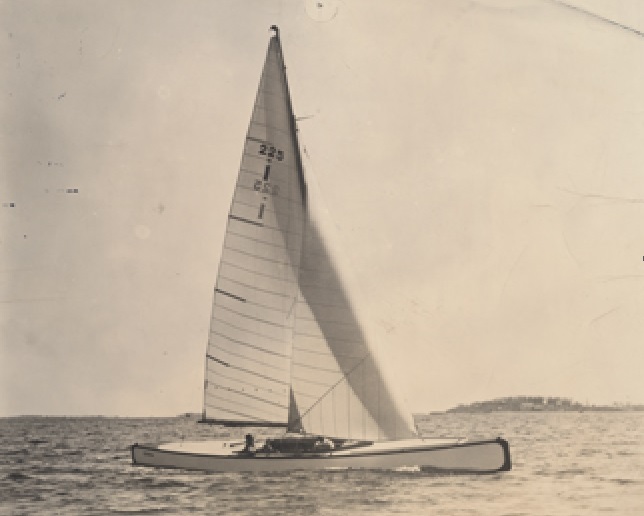
In 1939 The Corinthian Yacht Club members, of Marblehead, Massachusetts, were looking for a spirited one-design club boat for Massachusetts Bay, having searched for a low cost, low maintenance solution they decided on and sponsored the Lawley 225. Further evolved and improved by C. Raymond Hunt and Frank C. Paine, “Egeria” was the first of the 225 class boats, known as 225/1. “Egeria” proved to be very fast, beating most of the class boats in Marblehead except the 30-Square-Metres.

In 1940, when most yards were at capacity producing war effort ships, Lawley’s, decided to enter into a sales contract with the Cape Cod Shipbuilding Company of Wareham, Massachusetts, whereby CCS purchased the entire building rights to the line of small sailboats developed prior to the start of World War II. This agreement allowed current owners a continuous flow of replacement parts, and for Lawley’s pre-war brand to be constructed without delay The pre-war list included the Lawley 110, now known as the International 110, the Lawley 225, the Lawley 15′ sloop, and the Lawley 8′ pram.
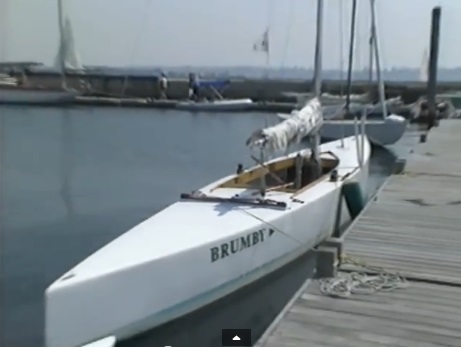
Hunt “Lawley 225″ Class Specifications:
LOA: 35’8″ / 10.85m * LOD: 35’8″ / 10.85m * LWL: 26′ 0″ * Beam: 5’0” / 1.55m * Draft: 4′ 0 / 1.21m * Ballast: 1,295 lbs * Displacement: 2,450 lbs* Original Sail Area: 225 * Sail Area By Rule: 233 sq ft * Yard Number: Prototype * Hull material: Weldwood Construction * Rig: Sloop * Designer: C. Raymond Hunt * Built by: George Lawley & Son, Neponset, Massachusetts * Year First Built: 1936 * Contract Cost: $1,150 w/o sails
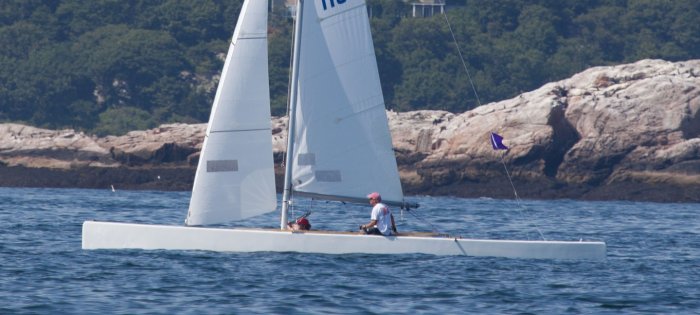
Past Ownership (Class) History:
1.) Lawley 225 Class – (Egeria) sail number 225/1
2.) Lawley 225 Class – (Briggs Cunningham- Top 6-metre sailor)
3.) Lawley 225 Class – (Brumby Tom Callahan) – (Brumby Museum of Yachting, Donated by Mr. Callahan) – (Jaws ?) – (Dagger Ted Boynton)
*Three class boats that we know about (so far)
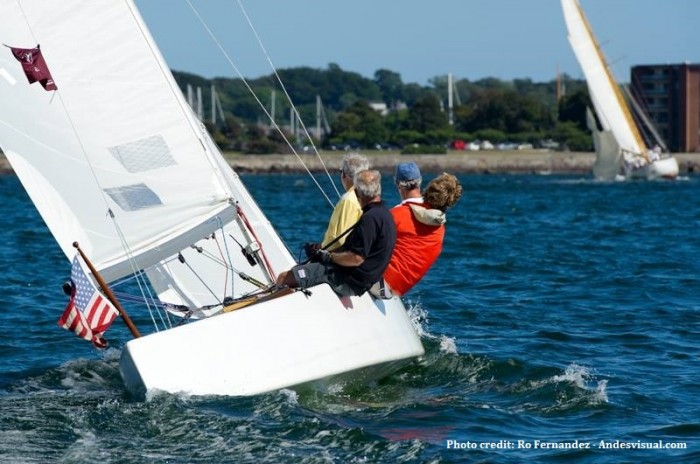
Known Racing History:
2014 – MoY Classic Yacht Regatta Class Grand Prix Winner (Dagger), skippered by Ted Boynton
1993 – MoY Classic Yacht Regatta Class D Winner (Brumby), skippered by Tom Callahan
Known Restoration History:
Historical:
Dagger is the last remaining, in sailing form, Lawley 225 in existence. A second existing hull was reported to be in the Midwest and is currently being used as a flower box.
Jaws – Dagger – Previous owner used a J-24 rig, current owner sails with an Etchell’s rig
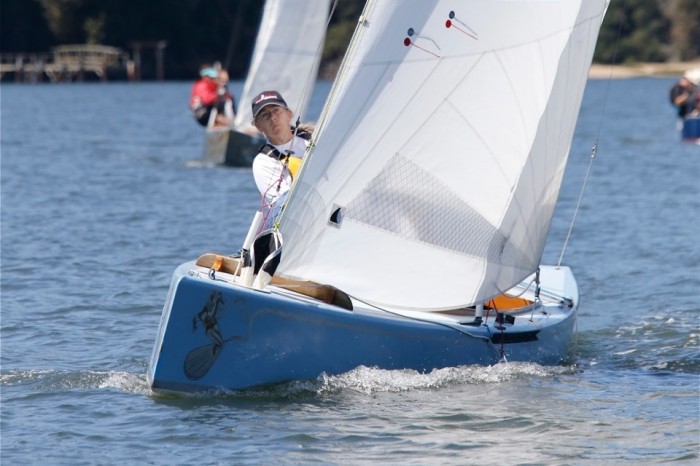
2014 OCTOBER CLASSIC SAILBOAT OF THE MONTH – C. Raymond Hunt International “ONE-TEN” –
In 1936 Raymond Hunt along with engineers Bror Tamm and Gordon Munro decided to build a 36’0″ prototype at the Lawley Yard in Neponset, Masachusetts. Although there were doubts about her potential sailing abilities, she quickly proved doubters wrong. But, at the time, no one seemed to want one, the prototype was too peculiar, and slab-sided for her size.
After much thought and consideration the Raymond Hunt brain trust decided to scale down the 36′ prototype twelve feet. The new yacht was called the International 110, and with it a new era in yachting was ushered in.
By the late 1930s yacht construction prices were skyrocketing. Through Hunt’s association with Lawley’s in the mid to late 30s, Raymond began experimenting with a new boat building material Harborite Plywood. The miracle overlayed fir plywood, offered “Armor Plate” protection with two tough, abrasion resistant surfaces of plastic resin impregnated fibres that are permanently welded together, creating a seamless easy, and cost effective way to build a boat. The 110 was built with four 12 foot sheets of Harborite laid over laminated oak frames and would use a simple rig with a rated sail area of 110 square feet, hence the name.
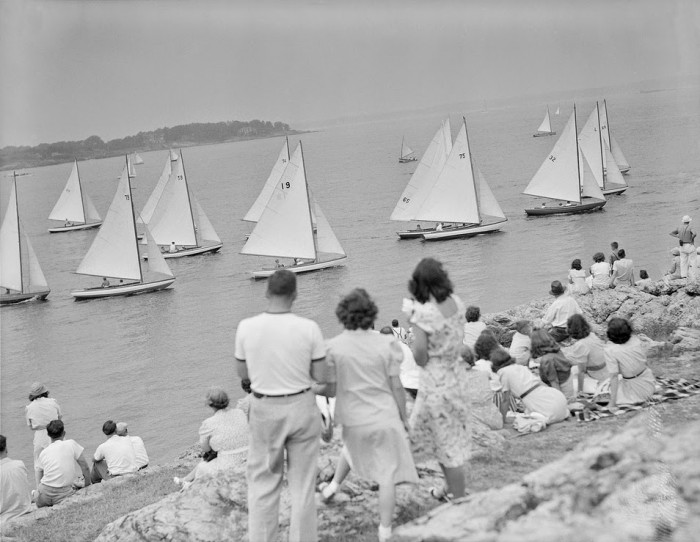
The International 110 was introduced at the 1939 Marblehead Race Week Regatta. Ray Hunt raced the boat around the coarse beating everyone boat for boat except the International One Design. With a price of $480.50 with sails the demand for this vessel began in earnest.
Ray Hunt would forever change the sailing world, hundreds of his new 110 design were being delivered as fast as they could build them. Unheard of for the time period, where other ship yards at best were producing 6-8 yachts a year, there were over 400 hulls built in a two year time period. Today as true testament to Hunt’s abilities, the 110 is still in production, and recently the class celebrated its 75th anniversary in Marblehead, Massachusetts, the place where things all began in those depression years prior to World War II.
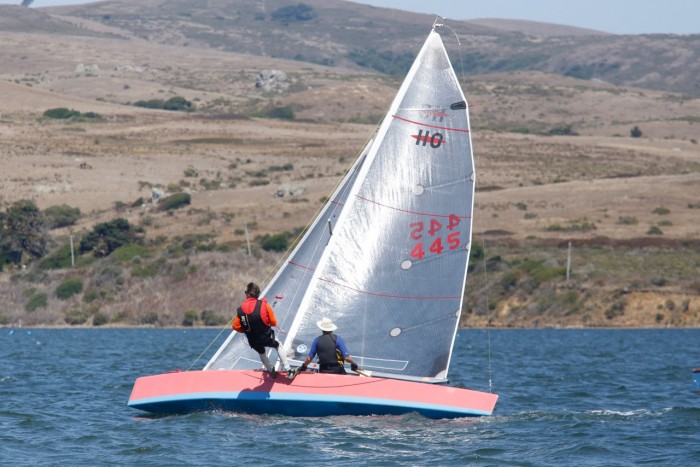
Other innovations that were created through the nimbleness and speed of the 110 was the creation of a trapeze system. A simple wire and harnessing system that allowed crew weight to extend outboard. The one ten was iconic in the harbors there were used in, ultimately claiming namesake to today’s ultralight sport boat concept.
Through the initial aesthetic development of the 110, it was believed that painting the hull in such a way that would accentuate the roundness of the edges was absolutely necessary, if the shape of the hull is to look well. The new painting schedule was encouraged, but was often overlooked, in favor of more budget friendly all in one color paint scheme.
The Internation 110 is still in production, the current builder is Westease Yacht Service, Inc., 66th St & 135th Ave N, Saugatuck, MI 49453, Phone: (616) 394-0076. There are active racing fleets across the US in Maine, Massachusetts, Rhode Island, Connecticut, New Jersey, Illinois, Michigan, California and Hawaii.
International 110 Specifications:
LOA: 24’0” / 7.3m
LWL: 18’0″ / 5.5m
Beam: 4’0” / 1.2m
Draft: 3’0” / 0.91m
Displacement: 910 lbs
Ballast: 300 lbs
Designed: C. Raymond Hunt
Hull material: “Harborite” Plywood Construction
Original Contract Cost: $480.50
Sail Plan: Main, Jib, Spin
Spinnaker: Conventional
Upwind sail area: 157 sq ft
Spinnaker sail area: 100 sq ft
Mast Height: 23’0″
Crew: 2
In production: Yes
Class Website: International 110 Class
Approximate number built: 750+
2014 SEPTEMBER CLASSIC SAILBOAT OF THE MONTH: George Owen P-Class Yacht “Bernice”
The Hodgdon yard of East Boothbay, Maine launched the 55-foot “P-class” gaff-rigged sloop in 1916. BERNICE was designed by George Owen, a contemporary of Nathaniel Herreshoff. L. Francis Herreshoff once said “George Owen’s yachts could even be said to be beautiful, and this adjective could only be truthfully applied to a few things in this world.”
Owen was known for producing consistently excellent racing yachts, and for his work developing rating systems. BERNICE is considered to be the last remaining Owen designed P-class boat. She sailed only a few years in the salt water of the east coast before moving to the Great Lakes. In the late 1920s or early 1930s she was re-rigged to a fractional marconi yawl and an engine was installed to facilitate cruising.
When Bernice arrived in Rockport for restoration, after spending much of her life in the fresh waters of the Great Lakes, the boat was in need of major work. All but four pairs of frames were replaced, and much of the planking as well. The boat is double-planked: outer layer is mahogany and the original inner planks are of cypress; any new planks are in western red cedar. To support the boat during this extensive rebuild, Rockport Marine created a support system that was bolted into the shop’s walls and ceiling.
As a racer, Bernice had a very spare interior, but Brendan Riordan, Rockport Marine’s designer, created a new arrangement plan to accommodate a family of four on weekend cruises and utilize the space available as fully as possible. There’s a master cabin aft, two berths amidships, and two pipe berths in the forepeak. The small galley has pressurized hot and cold water and refrigeration. A diesel heater was installed as well. Interior finish is mahogany stained a warm color and finished with ten coats of satin-finish varnish. A new main boom was part of the rebuild; new sails are by Nat Wilson and the rigging was completed by Tom Ward.
Bernice
Specs:
LOA: 53’4″, Waterline Length: 36’6″, Beam: 10’6″, Draft: 7’6″
Restoration by :
Rockport Marine
Contact:
1 Main Street
Rockport, ME, 04856
Phone: 207-236-9651
Website: www.rockportmarine.com
Launch Date:
May 2, 2008
Launch Site:
Rockport, Maine
2014 AUGUST CLASSIC SAILBOAT OF THE MONTH: Albert Strange “Shelia”
Shelia was Albert Strange’s first deep keel design commission, drawn for fellow artist Robert Groves who sailed her in the waters of the Scottish West Coast and the Hebrides in the early days of the century at a time when sailing such voyages in a small yacht was considered impossible. Named for Groves’ eldest daughter, she is the oldest known surviving Strange yacht.
1914 – “Sheila” was damaged in a storm in Dublin Bay, was written off by the insurers, sold to and rebuilt by Capt. Patrick Walsh of Dublin who added 5’ to the keel depth and fitted a rather exotic kauri pine swept deck.
1939 – Damaged by a bomb in a Scottish boat-yard
1978 – Present ownership, followed by an extensive largely professional restoration. The deck was removed and the hull stripped of all paint inside and out. The keel bolts replaced. All hanging and lodging knees replaced. Several deck beams replaced in Honduras mahogany. The interior rebuilt in the spirit of the original design with the help of Groves’ original drawings. The rig rebuilt.
Current – For up to date progress on “Sheila” visit The Albert Strange Association
Strange “Shelia” Specifications:
LOA: 31’0″ / 9.44m * LOD: 25’00 / 7.62m * LWL: 19’06 / 5.97m * Beam: 6’09 / 2.10m * Draft: 3’05 / 1.06m * Ballast: * Displacement: 4 TM * Sail Area: 330sq’ * Yard Number: * Hull material: Planked in full length ¾” Pensacola pitch-pine fastened with copper nails and roves to grown oak frames at 3’ centres with 2 steam bent intermediate timbers all on a very substantial oak back-bone. * Rig: Yawl * Designer: Strange * Built by: Robert Cain, boat builder in Port St Mary * Year Built: 1905 * Restored By: * Current Name: Shelia * Original Owner: Robert Groves * Contract Cost: * Current Owner: * Sail Number:
Sheila in the Wind, author Adrian Hayter – A inspirational story of a lone voyage on board the Albert Strange canoe yawl “Sheila”
2014 JULY CLASSIC SAILBOAT OF THE MONTH: E. G. Van de Stadt “Stormvogel”
Feared by ocean racers throughout the world in the 1960s was a design collaboration between 3 designers. E. G. Van de Stadt drew the hull lines, John Illingworth, the Sailplan, with Laurent Giles, construction details and general oversight. The collaboration was formed because The Van de Stadt Zaandam office, had absolutely no time available to develop the construction plan in great detail.
The owner, Kess Bruynzeel, decided to have the yacht built by his own company, Lamtico, in Stellenbosch, South Africa, using his revolutionary new product Bruynzeel plywood (“Hechthout”). Stormvogel’s hull was comprised of four layers of mahogany (total thickness 1.125″) glued using the newly-developed water-resistant synthetic resin glue and nailed together over longitudinal stringers on bulkheads. The resulting product was the world’s first Ultra-Light and Maxi-Boat sailing yacht, winning numerous races worldwide.
Van de Stadt, Giles, Illingworth “Stormvogel” Specifications:
LOA: 74’6″ / 22.73m * LOD: 74’6″ / 22.73m * LWL: 59’04 / 18.10m * Beam: 16’00 / 4.87m * Draft: 9’06 / 2.92m * Ballast: 29,000 lbs * Displacement: 62,000 lbs * Sail Area: 2,460 sq ft * Design Number: 17 * Hull material: Bruynzeel Plywood * Rig: Yawl * Designer: Collaboration – Hull: Van de Stadt, Construction Plans: Giles, Sailplan: Illingworth * Built by: Lamtico yard, Stellenbosch SA * Year Built: 1961 * Restored By: * Current Name: Stormvogel * Original Owner: Kess Bruynzeel * Contract Cost: * Current Owner: * Sail Number:
2014 JUNE CLASSIC SAILBOAT OF THE MONTH: Starling Burgess Designed (R-Boat) “Ruweida V”
Ruweida V is a 1926 Burgess, Swasey & Paine (BS&P) designed and Lawley built R boat. The Universal Rule, developed by Nathanael Herreshoff, was an improvement over the Seawanhaka Rule. The new rule yachts were classified by letters according to the boats length. Larger than the popular S-boats, R’s were smaller than the Q’s, M’s and the magnificent J’s.
The original owner, Sydney A. Beggs (Commodore of the Corinthian Yacht Club), sailed Ruweida V out of Marblehead, Massachusetts
Burgess “Ruweida V” Specifications:
LOA: 38.00′ / 11.58m * LOD: 38.00′ / 11.58m * LWL: 25’00” / 7.62m * Beam: 7’03” / 2.21m * Draft: 5’08” / 1.73m * Ballast: * Displacement: * Sail Area Original: 591 sq ft / 55m2 * Yard Number: * Hull material: Double Planked, Mahogany on Cedar with White Oak Frames * Rig: Sloop * Mast: * Designer: Starling Burgess * Type: R-Class * Built by: George S. Lawley & Sons, Neponset MA * Year Built: 1926 * Restored By: IYRS * Current Name: Ruweida V * Original Owner: Corinthian Yacht Club Commodore Mr. Boggs* Current Owner: * Sail Number: R3
Known Racing History:
2013 – NYYC Annual Regatta – First Overall
2013 – MOY Classic Yacht Regatta – First in Class
Known Restoration History:
2010 – International Yacht Restoration School – Complete restoration
2014 MAY CLASSIC SAILBOAT OF THE MONTH: Uffa Fox Designed “Vigilant”
VIGILANT was one of Uffa’s early ventures into keelboat design. Built in 1930, she is based on the 22 Square Metre Skerry Cruiser rules. She is of very light construction, so much so that the Q Class which raced on the Solent refused to allow her to compete.
Compared to the international 6 meter yacht, Vigilant is of about the same size, with half of the sail area, and half the displacement.
Fox “Vigilant” Specifications:
LOA: 34’6″ / 10.54m * LOD: * LWL: 25’06 / 7.80m * Beam: 6’4 / 1.95m * Draft: 4’3 / 1.31m * Ballast: * Displacement: 4,480lbs * Sail Area: 236 sq ft * Yard Number: * Hull material: Wood construction * Rig: Sloop * Designer: Fox * Built by: * Year Built: 1930 * Restored By: 1990-94 Andrew Thornhill * Current Name: Vigilant * Original Owner: Uffa Fox * Contract Cost: * Current Owner: * Sail Number: K1
In 1930 Uffa cruised 1,000 miles in Vigilant from Cowes to Sweden, to race in the Royal Swedish Yacht Club Centenary Races at Stockholm. He did not excel in the racing there, possibly because his racing experience had largely been in dinghies.
Vigilant was partly restored in the 1970s when her cabin was extended to provide better accommodation but was then laid up in 1975. She was rediscovered in Loddon, Norfolk by Andrew Thornhill who spent from 1990 to 1994 bringing her back almost to her original condition. Today she is part of the International Sailing Craft Association (ISCA) Maritime Museum’s fleet based at Lowestoft from where she has visited events as far apart as the Clyde and Solent.
She was one of the stars of the show at the Uffa Fox Centenary Regatta in 1998.
The boat is recorded in Uffa’s 1934 book Sailing
2014 APRIL CLASSIC SAILBOAT OF THE MONTH: Bruce King Designed “Antonisa”
Antonisa Specifications: LOA: 124’0″ / 37.80m * LOD: * LWL: 89’11 / 27.43m * Beam: 25’05 / 7.77m * Draft: 9′ 75 – 26’06 / 2.97m – 8.08m * Ballast: 106,000 lb * Displacement: * Sail Area: 6,761 sq ft / 628 sq m * Yard Number: * Hull material: Wood construction * Rig: Sloop * Designer: King * Built by: Hodgdon Yachts, Maine * Year Built: 1999 * Restored By: * Current Name: Antonisa * Original Owner: Pasquale Natuzzi * Contract Cost: * Current Owner: * Sail Number:
Wanting a larger version of the owners previous yacht “Whitefin”, Natuzzi hired Bruce King Yacht Design, to build a wooden yacht with the same aesthetics, allowing more space to accommodate his crew.
Owned by Italy’s largest furnishing firm, the Natuzzi Group, Antonisa is named after the owners wife. In honour of the owners son, the yacht is adorned with a little star on the stern, Natuzzi used to call his son Stelluccia, (Little Star) when he was small.
2014 MARCH CLASSIC SAILBOAT OF THE MONTH: David Hubbard Designed – Van Alan Clark Jr Concept “Red Herring”
Red Herring Specifications: LOA: 55’0″ * Beam 8’3″ * Displacement 9,500lbs * Draft Up:6’0″ Draft Down: 9’0″ Built: Goetz Custom (Hull 22) * Launched: 1980 * Keel: Canting 35 degrees * Sail Area Launched: 730 sq ft; Sail Area Current: 1,000 +- sq ft
Owner Steve Clark “Red Herring was designed by David Hubbard. The concept was all Van Alan Clark Jr. He got the germ of the idea from L. Francis Herreshoff’s “sailing machine” in the Common Sense of yacht design, but quickly identified the flaws in Herreshoff’s proposal and identified a way to address it. As Dave succinctly put it: to segregate the righting moment and lateral resistance functions of the keel into two appendages. Thus she has a strut with ballast on it to keep her upright and a daggerboard to keep her from sliding sideways.
“As originally launched she was a cat ketch with rotating masts and fully battened sails. She had two two centerboards a keel and a rudder. Keel canting was done by winches attached to massive 6:1 block and tackles, and she really didn’t work so well. Unfortunately my dad died in 1983 so he never really got to do much in terms of refining the concept. We knew it worked, but really didn’t know how well. After Dad died, Dave had her for a few years, and I took possession sometime around 1988. I have been nibbling away at it ever since.
I redesigned the sail plan. Moved the main aft 30″ to bring jibs aboard, and a mast head asymmetrical. After a very loud and expensive noise, had GMT make some very nice light carbon masts to replace the heavy aluminum rotating spars.
Next I decided the centerboards were too small, and so installed a deep canard daggerboard. The keel was originally a wood/ composite blade with a fairly low aspect ratio bulb, when I decided I didn’t trust it anymore, I had Duncan MacLane and Paul Bogatai design a good one that was machined out of steel with a modern looking bulb. Finally this year, the rudder was upgraded from something that looked OK in the 1970s to a deeper hotter shit blade with a carbon [post that weighs about 1/2 of what the old blade did.
On board accommodation has never been a big feature of the Red Herring experience. Her cross section is a bit smaller than a
J24, so that’s about what you get, stretched out a bit. There is a head with a door, but if you are my size, it’s a challenge to wipe with the door closed. On the other hand, there is a stove with an oven, which makes hot coffee cake and danishes possible, which is about as civilized as it gets. You cannot stand up in the saloon except in the hatch. There is a nice aft berth under the mizzen, but you can’t sit up anywhere except under the hatch. Ezra Smith and I designed some sea hoods this year to make her a bit more habitable in the rain and Blizo and the team at Aquidneck Custom did a wonderful job of fabricating them as well as the new coamings that make it all work as part of our 30 year refit.”
2014 FEBRUARY CLASSIC SAILBOAT OF THE MONTH: Sidney DeWolfe Herreshoff “Arion”
In 1950, Sidney Herreshoff designed a boat, as a harbinger of times to come. Arion was built using an innovative new material – plastic resin reinforced with glass fibers – Fiberglass. ARION, at 42′ was to be the first large sailboat ever attempted in this material. Many were skeptical about the suitability of this material in large craft. In order to reduce the loads and strains that were to challenge this vessel, Mr. Herreshoff elected to minimize the hull resistance so that she could be driven with a small rig.
Arion, although innovative, was not popular at the time, possibly she was to much for the tradition sailors of the time. After her initial success, she soon faded from view.
As a testament to her construction, she was found nearly 50 years later, in a field, with a sound hull. Little else had survived, but her bones were good. After a thorough restoration Arion was re-launched on her 50th birthday.
Arion’s Specifications:
LOA: 42′ 0″ * LOD: 42′ 0″ * LWL: 37′ 11″ * Beam: 8′ 1″ * Draft: 5′ 6″ * Ballast: * Displacement: 10,500 lbs * Sail Area: 562 sq. ft. * Yard Number: * Hull material: Fiberglass * Rig: Ketch * Class: * Designer: Sidney DeWolfe Herreshoff * Built by: Anchorage Plastics Corp. * Year Built: 1951 * Restored By: Damian McLaughlin Boats * Current Name: Arion * Original Owner: * Current Owner: * Sail Number:
2014 JANUARY CLASSIC SAILBOAT OF THE MONTH: Marcus Glas GmbH “L95”
A family run business for nearly 90 years, Bootswerft Markus Glas GmbH was founded in Possenhofen in 1924. Originally building small dinghies, fishing barges, cruising centreboarders, and cruising and racing motor boats.
Markus Wolfgang Glas, one time World champion, five times European champion, and twelve times German champion was the instrumental force for building more than 200 dragons, sold to all countries of Europe, and in turn making Lake Starnberg the largest dragon fleet in the world.
Since 1995 Markus Glas GmbH boat yard has managed to fully re-establish a vintage 30 sq meter classic for modern day use. Adjusted to modern technical findings and current needs of sailors, the L95-type boat doesn’t stop to amaze. The dynamic qualities ideal for sailing with her noble wooden appearance are a successful combination, and with an optional 1,600 watts Electric motor allows secure handling from her mooring.
Tailor-made for Bavarian inland waters, the L95 turned into one of the most favourite products of the Markus Glas Boat Yard. In 13 years 48 boats of this type have been delivered making for lively one-design regatta racing, competing in the L95 Grand Slam and other competitions.
Klaus Röder “L95” Specifications:
LOA: 29.69′ / 9,05m * LOD: 29.69′ / 9,05m * LWL: 6.59′ / 2,01m * Beam: * Draft: 3.60′ / 1,10m * Ballast: 1366.87 lbs / 620kg * Displacement: 2866 lbs / 1300kg * Sail Area: 322.91 sq ft / 30 sqm * Yard Number: * Hull material: Moulded mahogany with 2 glued frames for mounting of the shrouds, Mahogany floors * Rig: Sloop * Designer: Klaus Röder * Built by: Bootswerft Glas * First Built: 1995 * Sail Number:
Company Website: Bootswerft Markus Glas GmbH
2013 DECEMBER CLASSIC SAILBOAT OF THE MONTH: JOHN BRADY “BULL AND BEAR SANDBAGGERS” – Photo Courtesy of Tom Price – Annapolis. MD
Brady “Bull and Bear” Specifications:
LOA: 55’0 / 16.7m * LOD: 28’0 / 8.5m * LWL: * Beam: * Draft: * Ballast: * Displacement: * Sail Area: * Yard Number: * Hull material: Wood construction * Rig: * Designer: John Brady / Replica 1860s “Sandbaggers” * Built by: Independence Seaport Museum Workshop * Year Built: 1995 & 1996 * Restored By: * Current Name: Bull/Bear * Original Owner: Peter Kellogg * Current Owner: * Sail Number:
Known Racing History: ?
Known Restoration History:
Historical:
Stockbroker Peter Kellogg inspired and funded the building of two Sandbaggers, Bull and Bear, at the New Workshop on the Water in Philadelphia’s Independence Seaport Museum. The plans were drawn by John Brady, who also led the building project helped by shipwrights Newt Kirkland, Bob Ranson, and Sean Corson.



